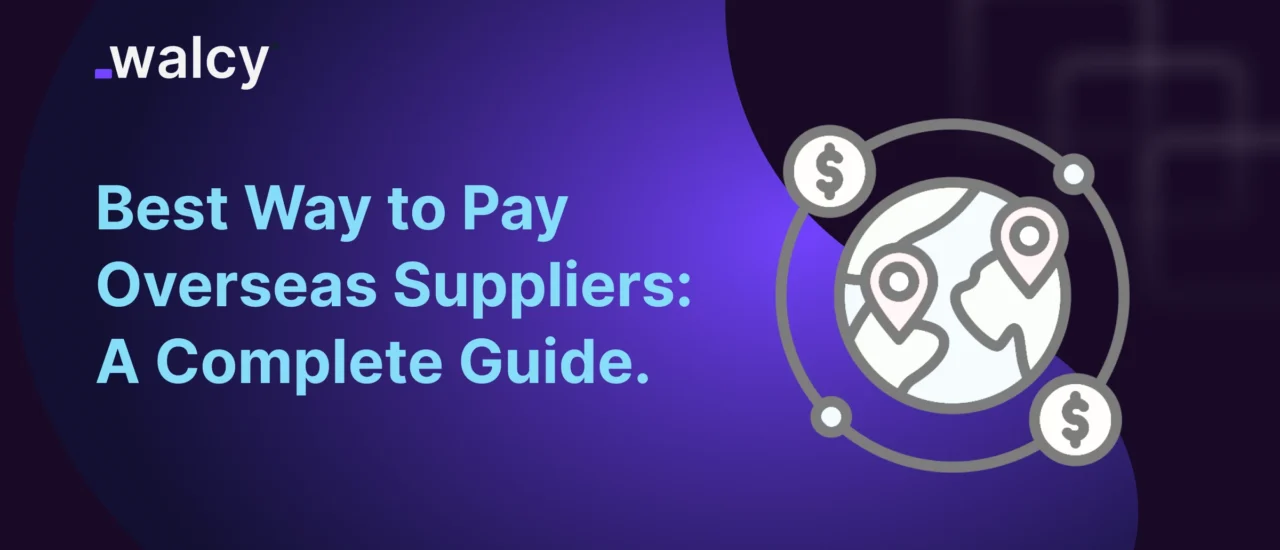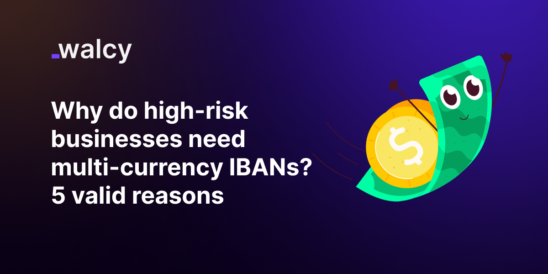For most US businesses of today, the supply chain has to cross national borders.
Paying your foreign supplier effectively and securely can guarantee the seamless functioning of your firm and foster important international business partnerships, whether you source from Europe, Asia, or even Australia.
Generally speaking, however, the problem of international payments involves considering the exchange rate, fee, security, and speed.
This complete guide to the best way to pay overseas suppliers involves different methods and provides great tips for US businesses.
Why Choosing the Right Payment Method is Important
Effectively paying overseas suppliers is not just about transferring the money; it’s ensuring that transactions are smooth, cost-effective, fast, and secure.
A great payment system will do the following:
Minimize Transaction Costs:
International payments always seem to have hidden fees, exchange rate margins, and administrative charges.
The selection of appropriate means may save your business in the long term.
Increase Speed of Payment:
Slowness in international payments can delay one’s supply chain, delay deliveries, and even cost one great opportunity.
Timely payments ensure that money reaches your suppliers on time and keeps your business in motion.
Provide Transparency:
Transparency in payments helps cultivate trust between customers and suppliers.
This will lead to easier and better transactions that culminate in very strong business relationships.
Offer Security and Fraud Protection:
When paying overseas suppliers, it is important to protect your business interests and those of the supplier against fraud.
A secured means of payment will offer protection against unauthorized access or fraud.
Read about: All About Overseas Payments (2025) Comprehensive Guide
Best Way to Pay Overseas Suppliers
Now that we understand why choosing the right payment method is important, let’s review the best ways to pay overseas suppliers both in the USA and abroad, including options for vendors in regions like Europe, Australia, and Asia.
Bank Wire Transfers
Bank wire transfers have been one of the more traditional means of paying overseas suppliers, especially when large transactions are concerned.
This is reliable and secure, and most suppliers worldwide accept this method very well.
How It Works:
Wire transfers are initiated from your US bank account to the supplier’s bank account abroad.
In most cases, there are imposition fees by sending and receiving banks, and an applied exchange rate margin.
Pros:
- Safe and Sure: Wire transfers are secure and widely trusted for large payments.
- International Acceptance: Most of the world’s banks take wire transfers. It is ideal to pay international vendors by wire.
- Suited for Large Payments: When it comes to huge payments, wire transfers are seen to be among the safest and most efficient methods of transferring money.
Disadvantages:
- High Fees: The use of bank wire transfers can be expensive since a fee is charged both from the receiving and sending bank. This can be higher in international transactions.
- Time for Processing: It would take a few business days by wire transfer, which depends on the countries concerned in this transaction.
- Best for: Huge payments to well-established overseas suppliers where security and reliability are the priority.
Walcy
Walcy is the best way to pay overseas suppliers because it offers a seamless, secure, and cost-effective solution tailored to international business needs. Here’s why Walcy stands out:
Low Fees and Competitive Exchange Rates
Walcy minimizes transaction costs with lower fees and provides competitive exchange rates, ensuring your payments are efficient and cost-effective. This helps businesses save money compared to traditional banks and other payment platforms.
Speed and Efficiency
With Walcy, payments to overseas suppliers are processed quickly. The platform’s advanced technology ensures minimal delays, keeping your supply chain moving smoothly.
Global Accessibility
Walcy supports payments in multiple currencies and countries, giving you the flexibility to work with suppliers worldwide without worrying about conversion issues or limitations.
PayPal
Paypal is among the major web-based payment systems used in most parts of the world.
With the PayPal system, US companies have the opportunity to make swift and secure payments to overseas vendors.
This has been beneficial for small and medium-scale businesses.
How It Works:
- You and your supplier must have a PayPal account.
- You attach your bank account or credit card to PayPal and can transfer the money in real-time to the supplier’s PayPal account.
- PayPal automatically converts the currency at its current exchange rate.
Pros:
- Speedy Transactions: PayPal transactions can be processed virtually in real-time.
- Wide Acceptance: PayPal is accepted in most countries and is used by a lot of small and medium-sized businesses.
- Security: PayPal offers buyer protection, hence is safe for paying international vendors.
Disadvantages:
- Fees: PayPal charges some fees for international transactions. The margin on the exchange rate may be higher than the one in other means.
- Limited for Large Transactions: PayPal is not suitable for large amount payments because of the fees and limits placed on transactions.
Best for: Small to medium-sized payments, especially for e-commerce and service-based businesses that have to pay suppliers quickly and securely.
Read about: The Impact of Exchange Rates on the Global Economy
Wise (formerly TransferWise)
Wise is an extremely well-regarded provider of international money transfer services primarily because of its transparency and fairly decent exchange rates.
For US-based businesses looking to pay overseas suppliers online, Wise can work as an alternative to regular bank transfers.
How it works:
You first log in to your Wise account, then specify the recipient by filling in the bank account details.
Wise does the currency conversion based on the real-time set exchange rate, charging low fees with no hidden costs.
Pros:
- Low Fees: It offers some of the lowest fees in the industry. The service is very transparent about fee structure and exchange rates.
- Great Exchange Rates: It is more common for Wise to give favorable mid-market exchange rates compared to traditional banks.
- Fast Transfers: The transfers take 1-2 business days according to the countries involved.
Cons:
- Not Available Everywhere: Although it’s expanding, Wise is still not available in every country or currency.
- Best for: Paying overseas suppliers in Europe, Australia, and other regions where Wise operates.
This would highly be more suitable for those businesses trying to reduce extra charges and also smooth transfers.
Crypto-asset Payments
Cryptocurrency has started to become a modern form of payment for offshore vendors.
Even better is the fact that thanks to advancements in blockchain technology, digital currencies like Ethereum and Bitcoin are now proving to be safe, completely decentralized ways to move money without the need for banking systems.
How It Works:
You and your vendor mutually agree upon making the payments in cryptocurrency.
The payment is forwarded over a blockchain-based network, after the agreement on the transaction, to the wallet address of the supplier.
Pros:
- Lower Transaction Fees: Most times lower than conventional methods, in particular, large payments.
- Speed: The transactions in cryptocurrency can be processed in minutes without depending on the geographical location of the supplier.
- Global Accessibility: It makes it possible to pay suppliers from all over the world without crossing national borders and bypassing various restrictions.
Cons:
- Volatility: The cryptocurrency is very volatile; thus, the value of the payment might change even before it reaches the supplier.
- Regulatory Uncertainty: Not all countries or suppliers may be open to this form of cryptocurrency payment.
The regulatory environment surrounding cryptocurrencies is not yet fully established.
Best for: Businesses that are very tech-savvy and whose suppliers can accept cryptocurrency. Unsuitable for businesses that have to be certain of payment amounts.
ACH Transfers:
An ACH transfer is the alternative option, which should be safe as well as economical, for US companies paying foreign suppliers, but especially paying suppliers in the USA.
How It Works:
ACH works within the circle of the US banking system in money transfers from one account to another, usually at lesser fees compared to wire transfers.
International payments are possible with US banks and, where applicable, internationally through their affiliated networks.
Pros:
- Low Fees: In most instances, the fees of ACHs remain pretty low as compared to wire transfers.
- Direct Bank Transfers: Since ACH payments are linked directly to bank accounts, there is less chance of fraud or error.
Cons:
- Limited to US Transactions: Generally speaking, ACH transfers are used for payments within the US, and international payments might take additional steps of processing.
- Slow Processing Times: The processing of ACH transfers can take 1-3 business days.
Best for: Payments within the US or between US-based suppliers and international vendors with an ACH-compatible account.
Credit Cards
The other option is to pay the overseas supplier by utilizing a business credit card.
For that, the reason is quite simple: most businesses in the US love flexibility in paying schedules, not to mention points or rewards.
How It Works:
The US-based business charges for goods or services against the business credit card.
The supplier immediately gets his money through the credit card network, and the business settles with the credit card company in its billing cycle.
Pros:
- Immediate: The suppliers are paid immediately.
- Offers and rewards: Most business cards offer some forms of rewards, like cashback or points against travel, which are good for the business.
- Protection from Purchase: Purchases made through credit cards normally have some level of buyer protection to protect from fraudulent issues or disputes arising in the transaction.
Cons:
- Fees and High Interest Rates: Credit cards have high interest rates, and for international payments, additional charges might also be there because of currency conversion.
- Credit Limits: There are limits to the amounts that can be spent on credit cards, which may be inappropriate for larger payments.
- Best for: Smaller, regular payments to suppliers where speed, flexibility, and rewards are important.
Escrow Services
Escrow services help make big deals with overseas suppliers when there is a need to create some sort of security in making payments.
Payment held by the neutral third party is an escrow agent and is released upon meeting the conditions specified in the agreement by the supplier.
How It Works:
- You, the buyer, deposit money into an escrow account.
- The supplier ships goods or provides services as per agreement.
- When the buyer has received it and he or she is satisfied with whatever they bought, funds get disbursed to the supplier.
Pros:
- Safety to Both Parties: Here, both buyer and supplier are safeguarded so that neither party has any risks of fraud.
- The Resolution of Dispute: When any dispute arises, there might be fair resolution disputes ensured by the services themselves.
Cons:
- Fees: The escrow services charge money for their service, which is generally more expensive than other methods of making payments.
- Complexity: It can be more time-consuming than other methods since verification needs to be made and disputes resolved.
- Best for: Large transactions or high-risk payments where both parties require additional security and protection.
Conclusion
Where the selection of the method of paying overseas suppliers is concerned, US businesses can consider a host of different options.
Normally, the best payment method would depend on the amount of the transaction, the countries importing and exporting, the urgency for the payment to be made, and the security to be maintained.
While popular options include wire transfers, PayPal, Wise, and cryptocurrency with their own sets of pros and credit cards and escrow services may be more suitable for those who require flexibility and safety.
Choose the right kind of payment method by weighing properly your needs and following your business strategy so that international transactions may smoothly take place.
Do follow us on Facebook and LinkedIn, to stay connected with us.



